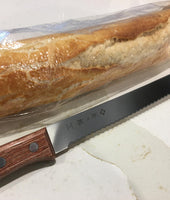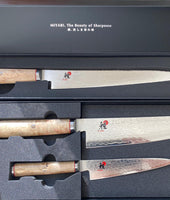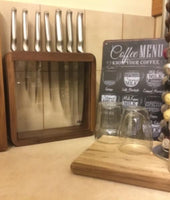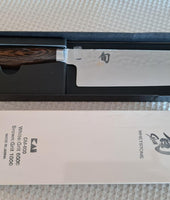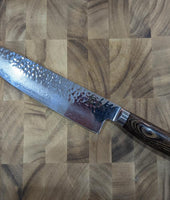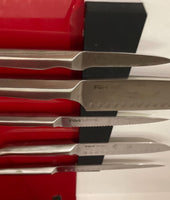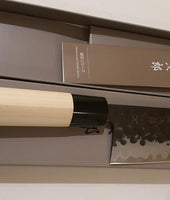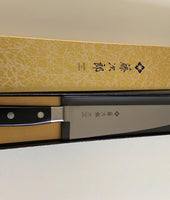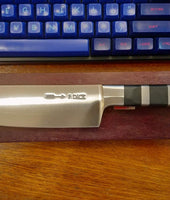For most chefs, cooks, and kitchen enthusiasts out there, the knife is more important than anything else in the kitchen. It's the tool used to do most of the important kitchen tasks, which is why it's essential to take proper care of your knives and understand knife safety dos and don’ts. Uncared for knives tend to dull out (even those of the best quality), and a dull knife is impractical to use and also unsafe.
To make sure you're practicing proper knife safety, you have to take a look at how you handle and treat your knife. Whether it's a Japanese chef's knife of the highest quality or just your trusty kitchen knife that you bought at the grocery store, there are a couple of do's and don'ts to remember to ensure that your knife's sharpness and your safety in the kitchen.
In this article, we cover knife safety dos and don'ts as well as why it's important to practice proper knife care. Read on to find out more.
Why Take Care Of Your Knife?
It was mentioned earlier than the knife is the most important kitchen tool, and that's why professional chefs make sure to invest in a sharp and high-quality set of knives. But even the highest quality of steel can get dull over time, especially when the knife is used frequently. Having a dull knife in the kitchen is less than ideal and should be avoided.
The first reason you don't want a dull knife is the fact that they are dangerous. This is because a dull knife will require more pressure to cut through food. Using more pressure increases the chances of your knife slipping and causing an accident.
Sharp blades bite onto surfaces easier and therefore require less effort and pressure to use, decreasing the chances of accidents. On top of that, using a dull knife can be tiring and cause fatigue as compared to a sharp knife.
Proper maintenance of a knife will ensure that your blade will remain sharp and functional for a longer time and it will also reduce the risk of accidents in the kitchen.

Knife Safety Do's And Don'ts
Knife safety does not stop at keeping a knife sharp. When using a knife, it's important to be as safe as possible. To do this, you have to keep a couple of things in mind, and we take a look at these things in this section.
- Make Sure Your Knife Is Always Sharp
This was already brushed upon earlier, but it's very important to always make sure your knife is as sharp as can be to keep things safe. After all, you don't want to increase the chances of a kitchen accident or tire yourself out cutting through one piece of meat.
- Don't Put Your Knives In The Dishwasher
It may seem like the easiest way to keep your knives clean, but tossing all your knives into the dishwasher is a pretty bad idea.
This is because the dishwasher will toss the knives around in the machine which will cause the blades to bang against each other and the different surfaces in the washer. This can lead to your knives getting damaged and the blade edge becoming dull.

- Handle Your Knife Properly
One of the primary skills of a chef or any home cook out there is the proper handling of a knife. Chefs learn the proper way to handle a knife and the food that's being cut to make reduce the risk of accidents and slips as much as possible.
This is done by gripping the knife firmly either by the handle or the blade, depending on how much control and precision you want and what makes you comfortable. Additionally, it's best to use the "claw" technique when holding the food so you guide the knife with your knuckles while protecting your fingers.
- Don't Cut On Uneven Surfaces
The reason chopping board and cutting boards are staples in the kitchen are because you should always cut food on a flat surface. It's also best to use a wooden cutting board as they tend to damage and wear the blade of the knife less.
Plastic cutting boards and other hard materials can cause the blade to crack or get damaged.

- Make Sure To Understand The Purpose Of Each Knife
There are many different types of knives out there. Each of these types has their own specific purposes. Some knives are designed to cut meat, fish, and poultry, while others are meant for small foods and vegetables.
Using the wrong knife for the wrong purpose can lead to an accident and also damage the knife, so make sure you understand the set of knives you own and the purpose of each of the knives.
- Don't Store Your Knives In A Drawer
This may come as a surprise because a drawer is a convenient place to store knives, but the inside of drawers can be a place where mold and mildew develop.
Having these fungi grow on a knife's blade is unsanitary and can also result in your knife being damaged. So make sure to store them either in the box that the knife came in, or have a proper place where it can be stored like a magnetic strip or knife block.
Conclusion
Getting into the art of working in the kitchen can be a fun and fulfilling experience. And one of the first things one needs to do when learning the ropes of the kitchen is understanding proper knife care and practices.
There may be a lot to learn when it comes to knives, and it could take a while. But one of the best places to start is understanding the basic dos and don'ts of knife safety.
So now that you know the basics, it's time to get practicing and familiarizing yourself with the art of using kitchen knives. Shop now at our store and equip yourself with the world’s best knives at affordable prices.
Also Read: Japanese Kitchen Knife Buying Guide - Which Blade to Choose
Explore More Products: Tojiro Shippu Paring Knife 13cm |Tojiro Shippu Paring Knife 9cm | Tojiro Shippu Peeling Knife 7cm | Tojiro Shirogami Double-Bevel Nakiri Knife 16.5cm


























